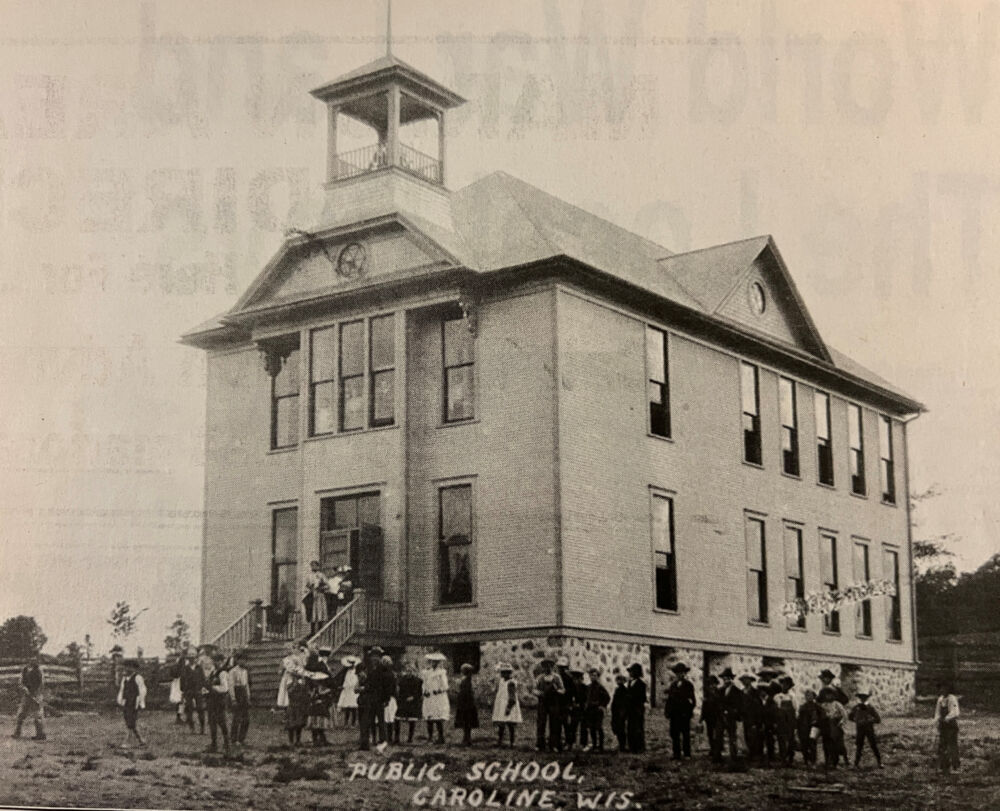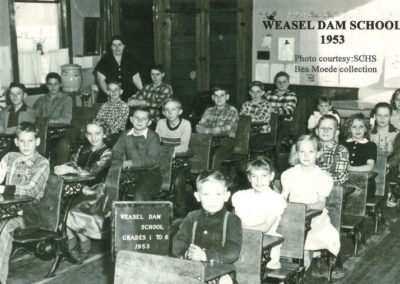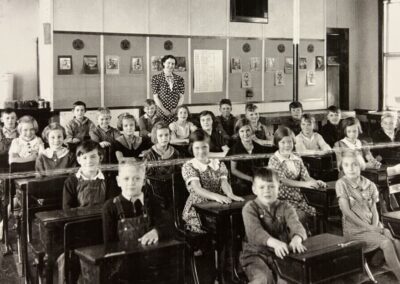Photo Gallery
1953 – Weasel Dam School, grades 1-8. Names listed below. Row 1: Charles Hintz, Sharon Wuske, Paulette Schuman, Dale Suehring, Sally Suehring, Myron Suehring, Bonnie Waters Row 2: Franklin Suehring, Luella Bredendick, Larry Watters, Danny Schuman, Gerals Wuske, Gary Buntrock, Elwyn Suehring Row 3: Otto Bredendick, Donald Buntrock, Teacher Mrs. Kathleen Murdock
CAROLINE ELEMENTARY SCHOOL – 1935 Fourth and Fifth Grade Row 1: Robert Mellin, Elroy Mehlberg, Vivian Dallmann, Marian Weber, Levi Lohff, Dawn Rebensdorf. Row 2: Robert Klaeser, Laura Haase, Lerie Lohff, Jeanette Schoen, Lawrence Wangeline, Lloyd Malueg. Row 3: Fern Alft, Gladys Romberg, Irene Dalum, Bianca Tornow, Ruth Wangeline, Darold Brockhaus. Row 4: Bernice Watters, James Hertzfeldt, Gordon Mielke, August Tabert. Row 5: Ralph Rebensdorf, Frank J. Buss, Walter Grunewald. Teacher: Emgard Reetz.
Grant Township Schools

CAROLINE PUBLIC SCHOOL
The first school was built on a tract of land about a half mile east of the village. It was a 10′ by 14′ building. It’s first teacher was Miss Minnie Lade. At that time many young people attended a German School which was taught by Rey. Dicke who served as a missionary for the Church now known as Immanuel Lutheran Church, located east of Caroline.
Boys and girls walked to this school from as far as 6 and 7 miles away. There they received their 3R’s in German. In a few years enrollment grew and there was a need for a much larger public school. In the 1880’s a one room school was built on the hill south of the village. The building served the purpose until the early years of 1900 when a large three room school was needed for the ever increasing enrollment. An interesting note was told that for many years this school never had a well and the teacher or pupils, and later the janitor, had to carry all water from below the hill to school. This three room school was used until 1950’s when the building was no longer seen as a safe place to have a number of children to be educated in. It was replaced by the new brick structure west of the village.
************************
1861, Caroline Public School was located one-half mile cast of Caroline. Minnie Lade was the first teacher. Eventually in the 1880’s, a one-room school was erected in Caroline on the hill, and Charles Netzel was the first teacher. In 1895, seventy-three pulls attended the school. The continued growth of Caroline led to le construction of another, larger three-room school in 1906. The school was built by O. Klaeser at a cost of $4,288 and erected on the hill in the same location as the building it was replacing.
Residents of the Caroline area also promoted parochial schools, and in 1865, a German Lutheran school was built in connection with the newly founded Immanuel Lutheran Church. It was originally located approximately two miles cast of Caroline, and he first teacher was Reverend Dicke. As enrollment increased, the parishioners decided to build a larger school in Caroline. 1 conjunction with its sister church, St. John’s, a new school was built in 1894 on Block 2, Lot 1, of Herman Buelter’s Addition. Professor Hugo Mosel was the teacher. Still another parochial school was erected a Caroline. Zion Lutheran Church constructed a school adjacent to the church in 1893. By 1895, eighty students attended the Caroline parochial schools, five more than attended the public school.
WEASEL DAM SCHOOL
School District #7 is located on the corner of Weasel Dam and Leopolis Road (North of Highway M and West of Highway G). The middle branch of the Embarrass River meanders through this section, and since sawmills and logging were the main source of business activity in the town of Grant, a dam was built west of where the school is.
Another business venture in that area was a broom handle factory, operated by George and Fred Frank, established in 1880. This settlement then became known as Weasel Dam, apparently due to numerous weasels inhabiting the woods and river.
Frank Suehring, Fred Strehlow John Frank, John Turner, Frank Uecker and Gust Klingbeil were the first settlers in this settlement. Prior to the building of a school their children attended German school in Caroline and Valley View school, which was 2 ½ miles away.
In March of 1915 money was appropriated to build a school. According to records the wooden building was erected on a corner of land that belonged to Ernest Popke for a total of $1867, including the land. This school served the townships of Grant and Seneca and was the main focus of social activity for these people.
The first school board consisted of Director Frank Suehring, Split Rock, Treasurer Albert Aschenbrenner (who resigned at once), Clerk Anton Osterhalt of Split Rock, Treasurer August Breitenfeldt of Caroline and Frank Uecker of Split Rock. Other family names were that of Emil Mensel, Albert Hintz and Jesse Stillman.
The first teacher in 1915 was Mary Bayer whose salary was $40.00 per month. From 1916-1930 the teachers were: Albert Cherney, Mabel Grignow, Gladys Ruppenthal, Marjorie Allan, Frances Gerend, Alice Popke, Irene Behnke, Alice Zenesk and James Klement. Salaries began at $40.00 per month rising to $100.00 per month. The school year was 160 days until 1930 when it was changed to 180 days. The day began at 9:00 o’clock and ended at 4:00 P.M. The students walked to school, the farthest being three miles. The number of students varied from 1918 – 22 students, 1918 – 29 students and numbered in the 20’s through these years up to 1950.
From 1930 to 1954 the teachers were: Clyde Herman, Katherine Prast, John Klement, Margaret Steckbauer, Art Spieth, Crystal Breitenfeldt, A. Johnson, Mr. Sanders, Kathleen Murdock and Carol Simpson, who was the last to teach there in 1954.
In 1917 the new family to enter a student to the school was Albert Pranke, 1918 – Gust Prankow, 1920 – Rheinhold Adams, 1921 – Frank Paiser, 1922 – Richard Grentz, Charles Frieumond, Louis Cerveny, Fred Suehring and Frank Kriesel, in 1923 – Fred Breitenfeldt and Adolph Dieck, 1924 – Albert Ashenbrenner, 1925 – Harry Breitenfeldt, 1926 – John Breitenfeldt, 1927 – Ernest Schwartz, Walter Fritz and Herman Kriesel. In 1928 – George Schewe, H. Dabler, and Al Hintz were entered then in 1930 – Otto Petrosky, 1934 – Marcus Suehring, 1936 – Louis Frank, 1940 – Clarence Wuske.
Several other families entering students in the school were: Adolph Hintz, Arthur Watters, Andrew Suehring, Lawrence Buntrock and Harvey Suehring. A new well was drilled in 1920 at the cost of $84.61 and the school was newly painted for $60.00.
During the year of 1945-46, there was no teacher available to teach, so the children were bussed to Tilleda. In 1955 the school was closed and the students attended Valley View School until 1957. Then the district became part of the Tigerton School District and students were taken to Tigerton by bus. In 1960 the building was sold to Marcus and Sophie Suehring for $150.00. They converted it into a tavern giving it the title “University of Weasel Dam”. In 1962 Dick Hass applied for a liquor license, and then sold it to Rudy and Carol Hidde in 1964. They sold it to Mr. Dekarski who converted it into a home. It is now owned by Clifford Rolloff. He remodeled the building, removed the bell tower and lives there still. The bell tower was purchased by Andrew Suehring, who was on the school board. Mr. Suehring sold the bell tower to Marten Radtke. Mr. Radtke sold the tower to his daughter, Connie Carpenter.
Being more or less the “Hub” of the Weasel Dam settlement, social events were quite few, but special. The Christmas program was one special event. The small children memorized their first “recitations.” The older ones sang Christmas songs and acted in plays. It was always an exciting time of the year for all when a curtain was hung on a wire that stretched across the front of the room. Not much was done academically during those days, as parts in the play were memorized, as well as songs to be sung and practicing the play parts was the main focus.
After the program was completed, jolly Santa Claus appeared and rewarded the children with bags containing candy, nuts, apples, oranges and popcorn balls. How they treasured those bags!
The other major social event was the last day of the school year – a picnic. Parents and grandparents gathered at the school bringing all sorts of picnic food including lemonade for the beverage and the meal ended with ice cream – a rare dessert for most families.
After their tummies were full, the men and boys teamed up for a softball game. The women stayed inside to catch up on visiting and the small children just enjoyed playing with each other. They probably wouldn’t see each other until the next fall when school started again. There was not much socializing during the summer, since the “ived a mile or more apart and the only means of transportation for them was by focus. Most of the children spent their summers helping their parents at home in gardens and After all was over, report cards were distributed and all were eager to find out if they “passed” to the next grade.
There was no playground equipment at the school so recesses were spent playing games such as “Ante Over” (the ball was thrown over the school building). Prisoners Base, Kick the Can and softball or hopscotch were also enjoyed.
School was held in all kinds of weather; it was never called off. If it was extremely cold coats and outdoor clothing was kept on until the building warmed up. The teacher had to build a fire every morning, so some days’ games were played to keep warm until it was warm enough to work.
On the acre of land where the school was bult, there was a small hill so in the winter some children would bring their sleds to school to slide down the hill at recess. Other games were: building snow forts and snow ball fights.
The teacher seldom came outdoors at recess to monitor the games, but the students spent little time fighting or disagreeing, as playtime in those days was precious.


